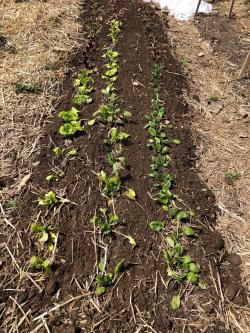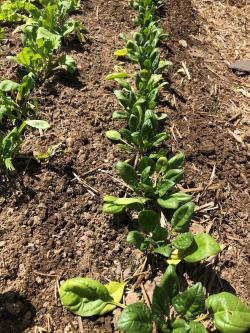Transplanting and Seeding, Row Covers, and Spinach
Frank Mangan and Heriberto Godoy-Hernandez
To read individual sections of this article, click on the section headings below to expand the content:
Welcome to the second week of Franco and Beto’s column on growing your own vegetables and herbs in Massachusetts. In this week’s column we focus on several topics, first of which is whether you can transplant or direct seed your vegetables and herbs in your garden.
Direct Seeding or Transplanting Vegetables and Herbs
Vegetable and herb species are either transplanted or direct seeded into the soil. Table 1 provides a list of some of the most common vegetables and herbs grown in Massachusetts and whether they should be direct-seeded or transplanted, and if both methods are possible. It also lists for each vegetable and herb crop which are frost sensitive, which is useful to know so you won’t plant vegetables and herbs when there is a chance of frost.
| Table 1. List of common vegetables and herbs grown in Massachusetts1 | |||
| Vegetables and Herbs | Direct seeded2 | Trans-planted3 | Frost Sensitive4 |
|
Asparagus |
No |
Yes | No |
|
Basil |
No | Yes | Yes |
|
Beans |
Yes | Yes | Yes |
|
Beet/Swiss Chard |
Yes | Yes | No |
|
Brassica family5 |
Yes | Yes | No |
|
Carrot and Parsnips |
Yes | No | No |
|
Celery and Celeriac |
No | Yes | Yes |
|
Sweet Corn |
Yes | Yes | No |
|
Cucumbers/Melons |
Yes | Yes | Yes |
|
Eggplant |
No | Yes | Yes |
|
Garlic |
No | Yes | No |
|
Leeks |
No | Yes | Yes |
|
Lettuce |
Yes | Yes | No |
|
Okra |
Yes | Yes | Yes |
|
Onions/Scallions |
No | Yes | No |
|
Parsley and Cilantro |
Yes | No | No |
|
Pea |
Yes | Yes | No |
|
Pepper |
No | Yes | Yes |
|
Potato |
No | Yes | No |
|
Pumpkin and Squash |
Yes | Yes | Yes |
|
Radish |
Yes | Yes | No |
|
Rutabaga and Turnip |
Yes | Yes | No |
|
Spinach |
Yes | Yes | No |
|
Sweet Potato |
Yes | Yes | Yes |
|
Tomatoes |
No | Yes | Yes |
| 1 Review the section in the New England Vegetable Management Guide for specific recommendations for each crop on when to seed, to what depth and seed spacing. 2 ”Yes” means the seed can be put directly into the soil and “No” means it cannot. 3 ”Yes” means the crop can be transplanted and “No” means it cannot. 4 “Yes” means the crop will die with a frost and “No” means it can survive a frost. 5 The brassica family includes broccoli, cabbage, cauliflower, bok choi, arugula among many others. |
|||
Vegetable/Herb of the Week: Spinach (Spinacia oleracea)
The crop of the week is spinach, Spinacia oleracea, which is native to Central and Western Asia and was brought to the Americas via immigration/colonization from Eurasia. Spinach is a hardy, cool weather crop, grown for use as a cooked green vegetable or for salad greens. Spinach can be seeded in the spring as soon as the soil can be worked.
For spinach, the temperature for optimum production and high quality is 55º-60º F with day length of approximately 12 hours. Under certain conditions, spinach will bolt (develop a seed stalk and flower), reducing quality. During summer months, high temperatures and long days will result in bolting, depending on the variety used (see Table 2 for varieties that have an “S” under “Season” for summer production).
Spinach can overwinter in temperate regions of the world but will not survive the winters of Massachusetts; however, spinach can overwinter in greenhouses and “high tunnels”, which will be described in later articles.
There are two main types of traditional spinach, smooth leaf and savoy (crinkled leaf) and there are also ”Asian” types. All grow equally well and are marketed similarly, but the savoy type, because of its crinkled leaf, is more difficult to clean. Asian leaf types are relatively smooth with pointed leaves. Table 2 provides a list of recommended varieties, types and optimum times of the season for growth. (Modified from the New England Vegetable Management Guide for spinach.
| Table 2. Spinach varieties and types recommended for New England* | ||
| Spinach varieties | Type** | Season*** |
|
Acadia |
Semi-savoy | SF |
|
Carmel |
Semi-savoy | SF |
|
Corvair |
Smooth | W |
|
Emporer |
Semi-savoy | SFW |
|
Escalade |
Semi-savoy | SF |
|
Flamingo |
Asian | SFW |
|
Pigeon |
Smooth | W |
|
Gazelle |
Smooth | F |
| * Taken from the New England Vegetable Management Guide. Many more varieties listed in the guide at https://nevegetable.org/crops/spinach ** There are two main types of spinach: smooth leaf and savoy (crinkled leaf) and also Asian types. *** Optimum seasons of the year for varieties are listed for each variety: S=spring, F=fall, W=winter. |
||
Here are some pictures and information on spinach transplanted into Franco’s garden this spring. I started this garden in 2010 in Shutesbury, Massachusetts, which is 1,200 feet above sea level. This soil was somewhat rocky and sandy, from to which I removed larger rocks and added composted manure and also added as well as lime according to recommendations by the UMass Soil and Plant Nutrient Testing Laboratory. (See the section on soil testing in last week’s article on how to get your soil tested – it is the only way to know how much and what specific amendments you should add, if any. As of this writing [5/18/20], the UMass Soil Testing Lab is closed due to the coronoavirus pandemic, but the UConn Lab remains open.)
Figures 1 and 2 show spinach transplanted into Francos’ garden on April 10th; the transplants were from a local farm store. One can see that some of the spinach leaves are yellow, more so on May 14th than April 25th, suggesting the plants have not taken up sufficient nutrients needed for optimum plant growth. I have applied ample amounts of compost over the years which will in turn provide considerable amounts of the nutrients needed by vegetables and herbs grown in this soil over time. The most likely reason for the yellowing of the leaves is due, in part, to this year’s unseasonably cool and wet weather during April and May. Soil temperatures and water play and important roles in the availability of nutrients which are taken up by plants. Soil organisms feed on organic matter and this process releases nutrients which are readily available for uptake by plants. The warmer the soil, the more microbial activity takes place and the more nutrients used by plants are released into the soil. Soil microorganisms need a certain range of soil moisture for optimum activity and optimum release of nutrients for plant growth. Overly dry and or saturated soils will drastically reduce microbial activity and plants will suffer on multiple levels, including access to soil nutrients See Fundamentals of Soil Health and Fertility in the New England Vegetable Management Guide.
Use of Row Covers
Vegetable and herb species are either transplanted or direct seeded into the soil. Table 1 above provides a list of some of the most common vegetables and herbs grown in Massachusetts and whether they should be direct-seeded or transplanted, and if both methods are possible. It also lists for each vegetable and herb crop which are frost sensitive, which is useful to know so you won’t plant vegetables and herbs when there is a chance of frost.
One practice to address cool soils in the spring and fall is the use of plastic mulch films, and slitted and floating row covers, which are well covered here, Plastic Mulch and Row Covers.
Here is another article on floating row covers, which is what I use in my garden, published by the University of Maryland Extension - Floating Row Cover.
Here are some pictures and comments related to floating row covers used by Franco Mangan in his garden and in his research. Figure 3 shows floating row cover over one bed of vegetables and herbs on March 13th. You don’t want to pull the row cover too tightly drawn over the plants which could cause damage to the growing points. It is called “floating” row cover since it is very light and the plants won’t be restricted in growth. I use rocks to hold the row cover down on all four sides. I “pull” the row cover to one side of a bed for weeding and harvesting (Figure 4). It is also important to check the plants as air temperatures increase after the spring since the row cover will trap heat which could create temperatures under the row cover that are too warm for certain crops species.
Click here for a video on how to use floating row cover in the production of vegetables and herbs.
Floating row cover can also be used for pest management. Figures 5 and 6 shows an acre of a crop called chipilín (Crotalaria spp.) grown as part of a research project at the UMass Amherst Research Farm in 2010. Floating row cover here was used to exclude a serious insect pest and the use of row cover was the most effective and efficient way to manage this insect.
(Informaiton on chipilín at a website maintained by Frank Mangan: www.worldcrops.org.





